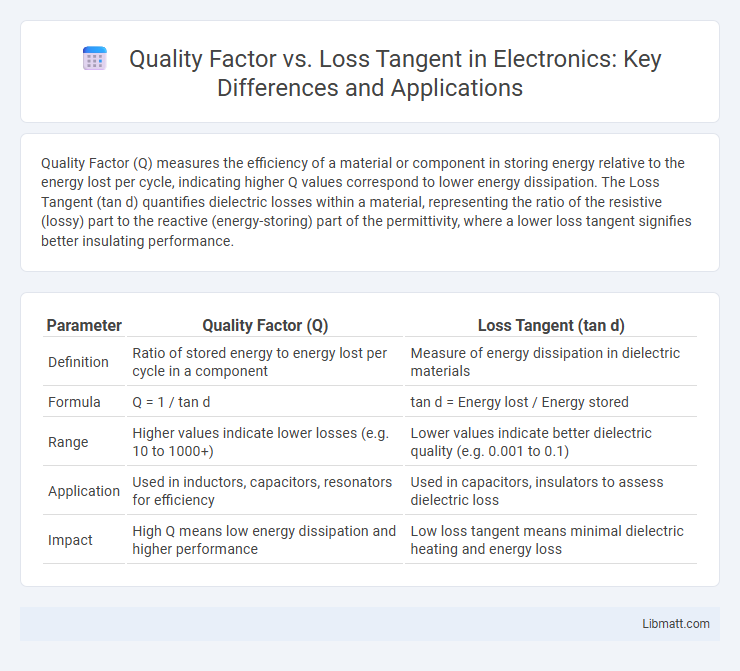Quality Factor (Q) measures the efficiency of a material or component in storing energy relative to the energy lost per cycle, indicating higher Q values correspond to lower energy dissipation. The Loss Tangent (tan d) quantifies dielectric losses within a material, representing the ratio of the resistive (lossy) part to the reactive (energy-storing) part of the permittivity, where a lower loss tangent signifies better insulating performance.
Table of Comparison
| Parameter | Quality Factor (Q) | Loss Tangent (tan d) |
|---|---|---|
| Definition | Ratio of stored energy to energy lost per cycle in a component | Measure of energy dissipation in dielectric materials |
| Formula | Q = 1 / tan d | tan d = Energy lost / Energy stored |
| Range | Higher values indicate lower losses (e.g. 10 to 1000+) | Lower values indicate better dielectric quality (e.g. 0.001 to 0.1) |
| Application | Used in inductors, capacitors, resonators for efficiency | Used in capacitors, insulators to assess dielectric loss |
| Impact | High Q means low energy dissipation and higher performance | Low loss tangent means minimal dielectric heating and energy loss |
Introduction to Quality Factor and Loss Tangent
Quality Factor (Q) represents the efficiency of a resonator or circuit by quantifying the ratio of stored energy to energy dissipated per cycle, directly impacting performance in oscillators and filters. Loss Tangent (tan d) measures the inherent dielectric losses in insulating materials, indicating how much energy from an electric field is converted into heat. Both parameters are critical in the design and optimization of high-frequency components, where low loss tangent and high quality factor contribute to superior signal integrity and reduced power dissipation.
Defining Quality Factor (Q): Meaning and Formula
Quality Factor (Q) represents the efficiency of a resonant system, quantifying the ratio of stored energy to energy dissipated per cycle. It is mathematically defined as Q = 2p x (Energy Stored / Energy Lost per Cycle), reflecting how underdamped the system is. Understanding Q helps you assess performance and energy losses in components like inductors and capacitors with respect to their loss tangent values.
Understanding Loss Tangent (tan δ): Concept and Calculation
Loss tangent (tan d) quantifies the energy dissipation in dielectric materials by measuring the ratio of the imaginary part to the real part of a material's complex permittivity. It reflects how much of the electrical energy is converted into heat within your device's insulating components, crucial for minimizing performance degradation. Calculating tan d involves the ratio of dielectric loss (e'') to dielectric storage (e'), directly impacting your system's overall quality factor.
Mathematical Relationship: Quality Factor vs Loss Tangent
The quality factor (Q) is mathematically defined as the reciprocal of the loss tangent (tan d), expressed as Q = 1 / tan d. This inverse relationship indicates that a lower loss tangent corresponds to a higher quality factor, signifying reduced energy dissipation in materials such as dielectrics. In practical applications, minimizing the loss tangent is critical for achieving high Q values in resonators, capacitors, and high-frequency circuits.
Importance of Q Factor in Electrical and Electronic Systems
The Quality Factor (Q Factor) is crucial in electrical and electronic systems as it quantifies the efficiency of resonators and filters by measuring energy loss relative to stored energy. A high Q Factor indicates low energy dissipation and sharper resonance, essential for signal clarity and effective frequency selection in circuits. Understanding your system's Q Factor helps optimize performance by minimizing losses, thereby enhancing overall reliability and efficiency.
Significance of Loss Tangent in Dielectric Materials
Loss tangent is a critical parameter in dielectric materials, measuring energy dissipation as heat relative to energy stored within the material. A low loss tangent indicates high-quality dielectric performance with minimal signal degradation, which directly affects the quality factor (Q factor) by defining how efficiently a material can store electrical energy. Understanding the loss tangent helps optimize your designs for high-frequency applications such as RF and microwave circuits where dielectric losses impact overall device efficiency.
Practical Applications: Where Q and Tan δ Matter
High Quality Factor (Q) components are crucial in resonant circuits such as filters and oscillators, where low energy loss ensures signal integrity and efficient performance. Loss Tangent (tan d) plays a key role in dielectric materials used in capacitors and RF substrates, determining energy dissipation and thermal stability in high-frequency applications. Q and tan d directly impact the design of microwave circuits, antennas, and precision measurement devices, optimizing performance and minimizing signal degradation.
Factors Affecting Quality Factor and Loss Tangent
Quality factor (Q) and loss tangent are influenced by material properties, frequency, and temperature. Impurities, crystal defects, and dielectric composition affect the Q by increasing energy dissipation, while loss tangent rises with higher dielectric losses and polarization mechanisms. Your choice of materials with low dielectric loss and stable thermal behavior enhances the quality factor while minimizing the loss tangent for optimal performance.
Measuring Q Factor and Loss Tangent: Techniques and Tools
Measuring Q Factor and Loss Tangent involves specialized techniques such as resonant cavity methods, network analyzers, and impedance analyzers to evaluate energy dissipation in materials and components. Tools like vector network analyzers (VNA) provide precise S-parameter measurements, enabling calculation of Q Factor by assessing resonance bandwidth and frequency. Loss Tangent is often determined using impedance spectroscopy or dielectric analyzers, quantifying dielectric losses and optimizing material performance in RF and microwave engineering.
Summary: Key Differences and Selection Guidelines
Quality Factor (Q) represents the efficiency of energy storage versus energy loss in a resonator, while Loss Tangent (tan d) measures dielectric dissipation in insulating materials. High Q values indicate low energy loss, making components suitable for applications requiring minimal signal attenuation, whereas a low Loss Tangent signifies excellent dielectric performance with minimal signal degradation. Selection guidelines prioritize Q for resonators and filters demanding sharp frequency responses, and prioritize materials with low Loss Tangent for capacitors and substrates in high-frequency circuits.
Quality Factor vs Loss Tangent Infographic

 libmatt.com
libmatt.com